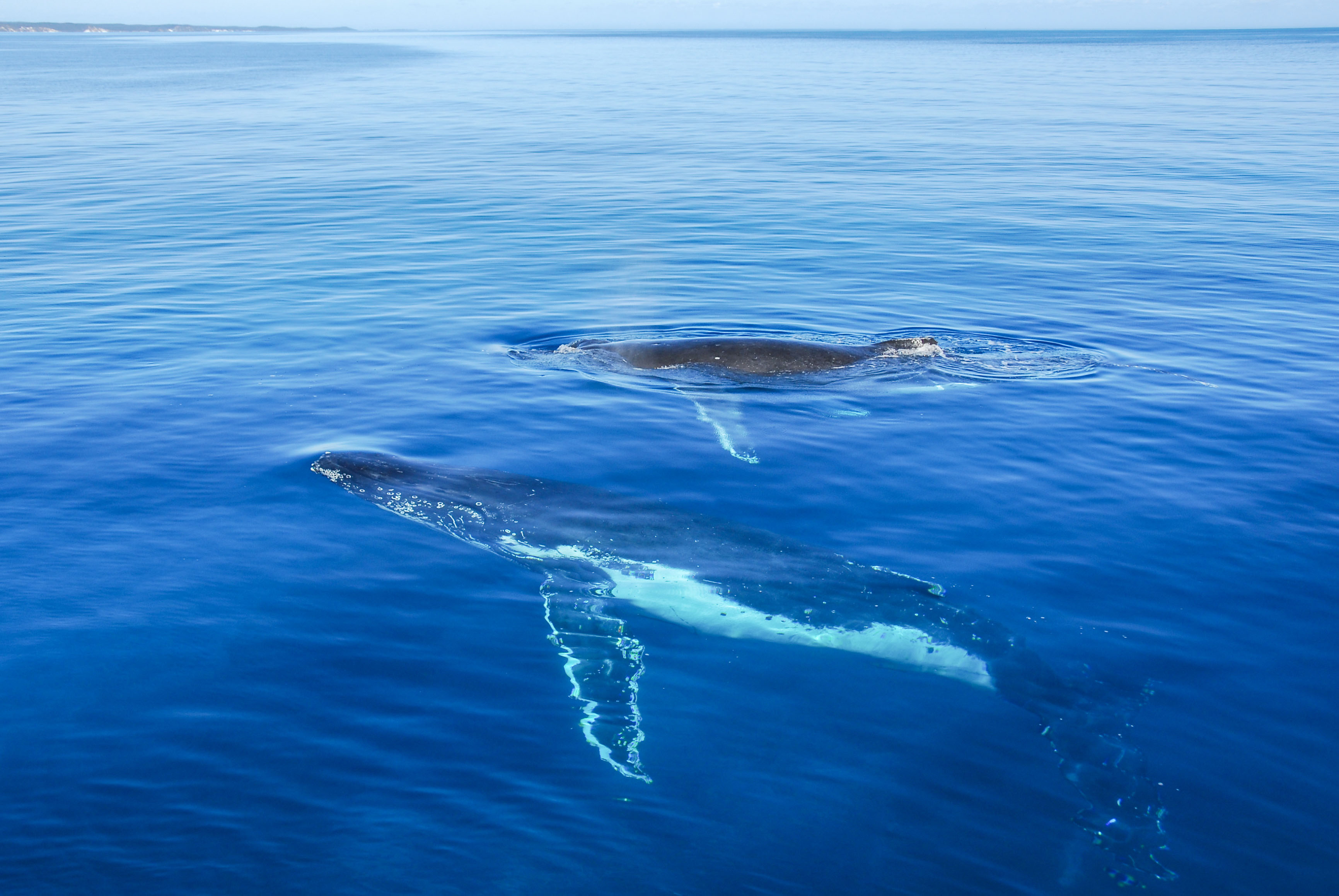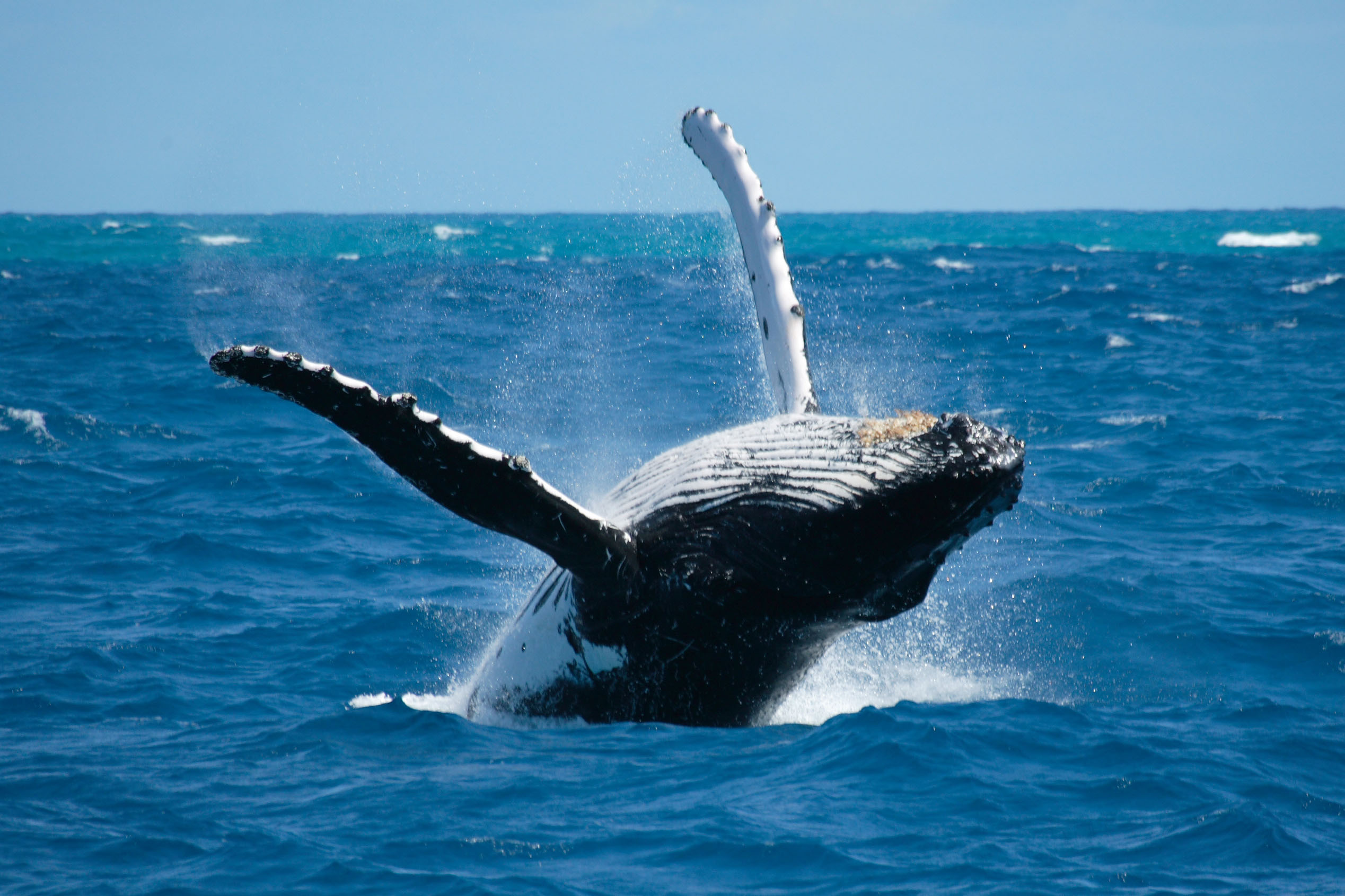Beyond escaping the chilly cold there is another reason why many people visit the state of Hawaii during the winter. Humpback Whales Season!
The North Pacific population of humpback whales are known to migrate to three different mating and birthing grounds during the winter. These locations are Hawaii, the southern islands of Japan, and Mexico. Hawaii receives the largest number of whales out of these three locations during the winter season, and Maui County receives the highest concentration of whales within Hawaii.
Humpback whales are found in oceans throughout the world, however, they only come to Hawaii after summer ends in Alaska. Towards the end of summer, the whales will leave the chilly Alaskan waters and swim south for six to eight weeks straight. For the whales to get from Alaska to Hawaii, it is about a 6,000-mile journey. They exhibit a trickling migration, meaning the whole population does not arrive in Hawaii at the same time. First, juveniles and yearlings arrive with their mothers. Next, the adult males and females follow behind, and finally pregnant females who are ready to give birth. Peak whale season is usually between January and February because this is when the whole group gets to Hawaii.
It is important to know that whales are protected within Maui County’s Humpback Whale National Marine Sanctuary. This area does not allow any boats, kayaks, paddle boards, or swimmers within 100 yards of a whale. When looking for whales, it is best to use a scanning approach. The first place to look is towards the horizon to see if there are any puffs of mist from a whale that are known as blows or exhalations. Humpback whales are air-breathing mammals, so they need to come to the surface to take a breath of air before diving. The record known time that time a humpback whale has been able to hold its breath is 59 minutes! Depending on their level of activity, the whale may surface frequently. Competition groups or surface-active behaviors usually signify the whale will be taking breaths every five to 20 minutes. You can compare their activity level to that of a human: the more humans move or exercise, the more oxygen we need to take in and the harder we breathe. The same is true with whales.
When looking for whales, it is best to use a scanning approach. The first place to look is towards the horizon to see if there are any puffs of mist from a whale that are known as blows or exhalations. Humpback whales are air-breathing mammals, so they need to come to the surface to take a breath of air before diving. The record known time that time a humpback whale has been able to hold its breath is 59 minutes! Depending on their level of activity, the whale may surface frequently. Competition groups or surface-active behaviors usually signify the whale will be taking breaths every five to 20 minutes. You can compare their activity level to that of a human: the more humans move or exercise, the more oxygen we need to take in and the harder we breathe. The same is true with whales.
Humpback whales are the 5th, 6th, or 7th largest species in the animal kingdom depending on which book you read. Adult whales reach lengths of 45 to 50 feet long and weigh a massive 80,000 to 90,000 pounds. That is the equivalent of squishing seven African elephants into a school bus. Newborn humpback whales, calves, are 10-16 feet long at birth weighing on average one and a half tons. The whale’s heart at adult size weighs 450 pounds as it has to pump as much as 750 gallons of blood through its body.
Watching whales is exciting, and people always want to know “why” whales exhibit certain behaviors at certain times. The answers lie within scientists, marine naturalists, and marine biologists who study and watch whales for a living. Though no one speaks whale just yet, scientists can interpret behaviors based on what whales do before and after a specific behavior. Any kind of splashing behavior can indicate communication or aggression. There could be a female who is being pursued by multiple males in hopes they may have a chance to mate, or a mother and calf pair where the mother is teaching the calf surface active behaviors such as breaching, tail slapping, or pectoral slapping.
Migrating
North Pacific Humpback Whales (Kohola) arrive in Hawaii after their journey from Alaska sometime from November to May, with most sightings January to March, making February the peak time. The more than 3,000-mile journey is believed to take as little as 36 days up to 4-6 weeks one-way. Marine scientists have noted that they typically travel between 3-7 miles per hour, with very few stops.
Mating and Birthing
Humpback Whales leave the icy waters of Alaska during the fall for warmer waters to mate, give birth, and nurture their calves. Not only does Hawaii offer warmer waters but a few other perks could be the underwater visibility, the variety of ocean depths, and the lack of natural predators. They have an 11 to 12-month gestational period, so baby Humpback calves are both conceived and birthed in Hawaii. So, it is safe to assume that last season’s breeding, becomes the following season’s birthing. During their time spent in Hawaiian waters, baby calves will learn the motor skills that are necessary for survival. These early learned behavioral skills will translate into the adult behaviors that will ensure their safety and livelihood for the long migration back to Alaska.
Whale Watching
Maui is without a doubt the best island for whale watching from the shoreline. You can watch them from the beach, your resort/lanai, or from a scenic lookout. The most common road to see the whales breaching and playing from a distance is between Ma’alaea and Lahaina of Highway 30. You can also leave the land and set out on the water for a closer look. There are plenty of boating tours to choose from or you can choose your favorite paddle sport (kayak, canoe, SUP).
North Pacific Humpback Whales Facts: While visiting Maui in the winter, you won’t want to miss these charismatic megafaunas. Take a whale watching tour with trained marine naturalists at the Pacific Whale Foundation, or enjoy a sunset cocktail sail with Trilogy. There are many options to choose for whale watching depending on where you’re staying. If you want to avoid the boat, you can even see whales from the beach.
While visiting Maui in the winter, you won’t want to miss these charismatic megafaunas. Take a whale watching tour with trained marine naturalists at the Pacific Whale Foundation, or enjoy a sunset cocktail sail with Trilogy. There are many options to choose for whale watching depending on where you’re staying. If you want to avoid the boat, you can even see whales from the beach.
About the Author: Skyline Eco-Adventures is the United States’ Original zipline company. With zipline tours on the islands of Kauai, Maui and the Big Island, Skyline Eco-Adventures has an adventure for every visitor. For more info or to make your reservation today, visit: www.skylinehawaii.com.
The North Pacific population of humpback whales are known to migrate to three different mating and birthing grounds during the winter. These locations are Hawaii, the southern islands of Japan, and Mexico. Hawaii receives the largest number of whales out of these three locations during the winter season, and Maui County receives the highest concentration of whales within Hawaii.
Humpback whales are found in oceans throughout the world, however, they only come to Hawaii after summer ends in Alaska. Towards the end of summer, the whales will leave the chilly Alaskan waters and swim south for six to eight weeks straight. For the whales to get from Alaska to Hawaii, it is about a 6,000-mile journey. They exhibit a trickling migration, meaning the whole population does not arrive in Hawaii at the same time. First, juveniles and yearlings arrive with their mothers. Next, the adult males and females follow behind, and finally pregnant females who are ready to give birth. Peak whale season is usually between January and February because this is when the whole group gets to Hawaii.
It is important to know that whales are protected within Maui County’s Humpback Whale National Marine Sanctuary. This area does not allow any boats, kayaks, paddle boards, or swimmers within 100 yards of a whale.
 When looking for whales, it is best to use a scanning approach. The first place to look is towards the horizon to see if there are any puffs of mist from a whale that are known as blows or exhalations. Humpback whales are air-breathing mammals, so they need to come to the surface to take a breath of air before diving. The record known time that time a humpback whale has been able to hold its breath is 59 minutes! Depending on their level of activity, the whale may surface frequently. Competition groups or surface-active behaviors usually signify the whale will be taking breaths every five to 20 minutes. You can compare their activity level to that of a human: the more humans move or exercise, the more oxygen we need to take in and the harder we breathe. The same is true with whales.
When looking for whales, it is best to use a scanning approach. The first place to look is towards the horizon to see if there are any puffs of mist from a whale that are known as blows or exhalations. Humpback whales are air-breathing mammals, so they need to come to the surface to take a breath of air before diving. The record known time that time a humpback whale has been able to hold its breath is 59 minutes! Depending on their level of activity, the whale may surface frequently. Competition groups or surface-active behaviors usually signify the whale will be taking breaths every five to 20 minutes. You can compare their activity level to that of a human: the more humans move or exercise, the more oxygen we need to take in and the harder we breathe. The same is true with whales.
Humpback whales are the 5th, 6th, or 7th largest species in the animal kingdom depending on which book you read. Adult whales reach lengths of 45 to 50 feet long and weigh a massive 80,000 to 90,000 pounds. That is the equivalent of squishing seven African elephants into a school bus. Newborn humpback whales, calves, are 10-16 feet long at birth weighing on average one and a half tons. The whale’s heart at adult size weighs 450 pounds as it has to pump as much as 750 gallons of blood through its body.
Watching whales is exciting, and people always want to know “why” whales exhibit certain behaviors at certain times. The answers lie within scientists, marine naturalists, and marine biologists who study and watch whales for a living. Though no one speaks whale just yet, scientists can interpret behaviors based on what whales do before and after a specific behavior. Any kind of splashing behavior can indicate communication or aggression. There could be a female who is being pursued by multiple males in hopes they may have a chance to mate, or a mother and calf pair where the mother is teaching the calf surface active behaviors such as breaching, tail slapping, or pectoral slapping.
Migrating
North Pacific Humpback Whales (Kohola) arrive in Hawaii after their journey from Alaska sometime from November to May, with most sightings January to March, making February the peak time. The more than 3,000-mile journey is believed to take as little as 36 days up to 4-6 weeks one-way. Marine scientists have noted that they typically travel between 3-7 miles per hour, with very few stops.
Mating and Birthing
Humpback Whales leave the icy waters of Alaska during the fall for warmer waters to mate, give birth, and nurture their calves. Not only does Hawaii offer warmer waters but a few other perks could be the underwater visibility, the variety of ocean depths, and the lack of natural predators. They have an 11 to 12-month gestational period, so baby Humpback calves are both conceived and birthed in Hawaii. So, it is safe to assume that last season’s breeding, becomes the following season’s birthing. During their time spent in Hawaiian waters, baby calves will learn the motor skills that are necessary for survival. These early learned behavioral skills will translate into the adult behaviors that will ensure their safety and livelihood for the long migration back to Alaska.
Whale Watching
Maui is without a doubt the best island for whale watching from the shoreline. You can watch them from the beach, your resort/lanai, or from a scenic lookout. The most common road to see the whales breaching and playing from a distance is between Ma’alaea and Lahaina of Highway 30. You can also leave the land and set out on the water for a closer look. There are plenty of boating tours to choose from or you can choose your favorite paddle sport (kayak, canoe, SUP).
North Pacific Humpback Whales Facts:
- The North Pacific Humpback Whale population has grown from approximately 1,400 in 1966 to 21,000 in 2014
- Average of 8,000-10,000 Humpback Whales visit Hawaii every year
- 5th largest whale species in the world (weigh 50-80k lbs and up to 60-feet in length)
- Life span is about 50-years
- Consumes up to 3,000-lbs of food per day (but never feed in Hawaii’s oceans)
- Polygynous mammals and are promiscuous breeders
- Males do not play a parental role in the early life of calves but they will protect and guard the female during their stay in Hawaii
 While visiting Maui in the winter, you won’t want to miss these charismatic megafaunas. Take a whale watching tour with trained marine naturalists at the Pacific Whale Foundation, or enjoy a sunset cocktail sail with Trilogy. There are many options to choose for whale watching depending on where you’re staying. If you want to avoid the boat, you can even see whales from the beach.
While visiting Maui in the winter, you won’t want to miss these charismatic megafaunas. Take a whale watching tour with trained marine naturalists at the Pacific Whale Foundation, or enjoy a sunset cocktail sail with Trilogy. There are many options to choose for whale watching depending on where you’re staying. If you want to avoid the boat, you can even see whales from the beach.
About the Author: Skyline Eco-Adventures is the United States’ Original zipline company. With zipline tours on the islands of Kauai, Maui and the Big Island, Skyline Eco-Adventures has an adventure for every visitor. For more info or to make your reservation today, visit: www.skylinehawaii.com.


